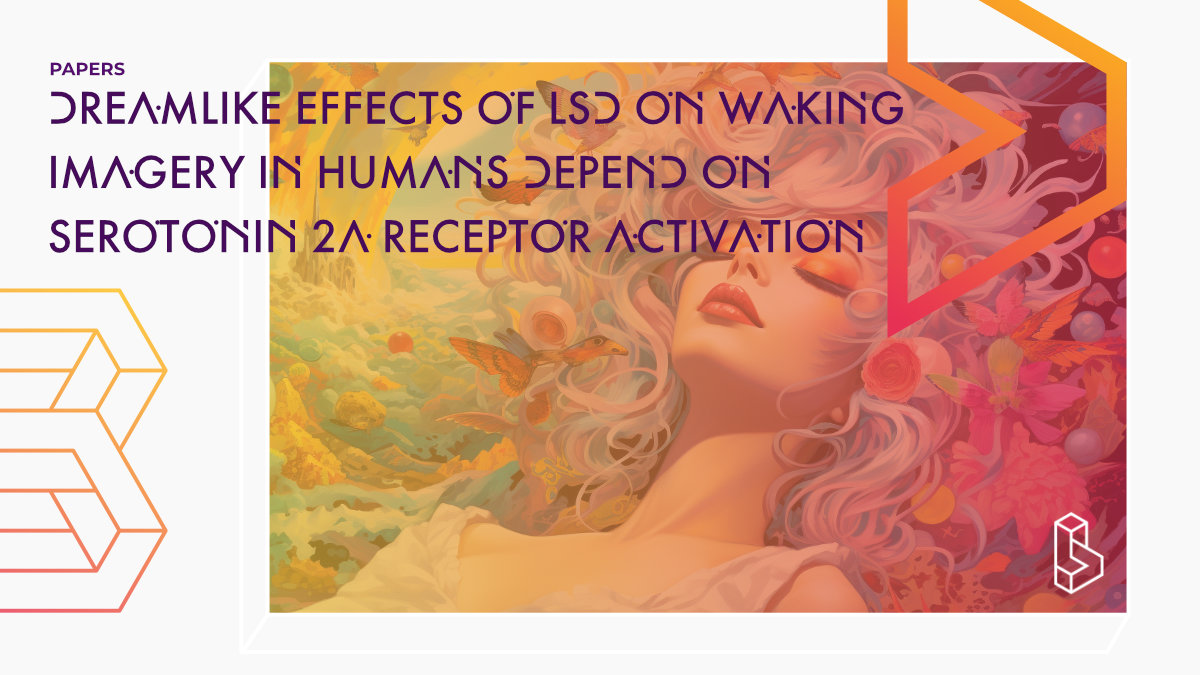This double-blind, within-subjects design, placebo-controlled study (n=25) found that LSD increased cognitive bizarreness, similar to imagery during dreaming. The effects (as usual) were blocked entirely when someone was pre-treated with ketanserin.
Abstract of Dreamlike effects of LSD on waking imagery in humans depend on serotonin 2A receptor activation
“Rationale: Accumulating evidence indicates that the mixed serotonin and dopamine receptor agonist lysergic acid diethylamide (LSD) induces an altered state of consciousness that resembles dreaming.
Objectives: This study aimed to test the hypotheses that LSD produces dreamlike waking imagery and that this imagery depends on 5-HT2A receptor activation and is related to subjective drug effects.
Methods: Twenty-five healthy subjects performed an audiorecorded guided mental imagery task 7 h after drug administration during three drug conditions: placebo, LSD (100 mcg orally) and LSD together with the 5-HT2A receptor antagonist ketanserin (40 mg orally). Cognitive bizarreness of guided mental imagery reports was quantified as a standardised formal measure of dream mentation. State of consciousness was evaluated using the Altered State of Consciousness (5D-ASC) questionnaire.
Results: LSD, compared with placebo, significantly increased cognitive bizarreness (p < 0.001). The LSD-induced increase in cognitive bizarreness was positively correlated with the LSD-induced loss of self-boundaries and cognitive control (p < 0.05). Both LSD-induced increases in cognitive bizarreness and changes in state of consciousness were fully blocked by ketanserin. Conclusions: LSD produced mental imagery similar to dreaming, primarily via activation of the 5-HT2A receptor and in relation to loss of self-boundaries and cognitive control. Future psychopharmacological studies should assess the differential contribution of the D2/D1 and 5-HT1A receptors to cognitive bizarreness.”
Authors: Rainer Kraehenmann, Dan Pokorny, Leonie Vollenweider, Katrin H. Preller, Thomas Pokorny, Erich Seifritz & Franz X. Vollenweider
Summary of Dreamlike effects of LSD on waking imagery in humans depend on serotonin 2A receptor activation
Serotonergic or classic psychedelics such as LSD produce vivid sensorimotor imagery, alterations in thought processes, and disinhibition of basic emotions and needs. Research shows that psychedelics induce a dreamlike state in humans, which is supported by phenomenological, neurophysiological and pharmacological evidence. However, the highly variable phenomenological content of psychedelic imagery has so far undermined attempts to show a stringent link between the psychedelic-induced state of consciousness and dreaming.
LSD induces dreamlike waking imagery, which can be measured by cognitive bizarreness. This study aimed to assess the relation between the effects of LSD on perception, mood, cognition and sense of self.
We combined pharmacological manipulation (LSD) and the selective 5-HT2A receptor antagonist ketanserin to investigate the specific receptor contributions to the cognitive effects of LSD in humans. The results suggest that stimulation of the 5-HT2A receptor mediates the effects of LSD on cognitive bizarreness.
Notes on Dreamlike effects of LSD on waking imagery in humans depend on serotonin 2A receptor activation
This paper is included in our ‘Top 12 Articles on Psychedelics and Serotonin (5HT) Receptors‘
This paper uses the same participants/study as Kraehenmann and colleagues (2017) who studied the effects of LSD on (increased) primary thinking processes.
Find this paper
Dreamlike effects of LSD on waking imagery in humans depend on serotonin 2A receptor activation
https://doi.org/10.1007/s00213-017-4610-0
Open Access | Google Scholar | Backup | 🕊
Cite this paper (APA)
Kraehenmann, R., Pokorny, D., Vollenweider, L., Preller, K. H., Pokorny, T., Seifritz, E., & Vollenweider, F. X. (2017). Dreamlike effects of LSD on waking imagery in humans depend on serotonin 2A receptor activation. Psychopharmacology, 234, 2031-2046.
Study details
Compounds studied
LSD
Topics studied
Neuroscience
Study characteristics
Original
Placebo-Controlled
Double-Blind
Within-Subject
Participants
25
Humans
Authors
Authors associated with this publication with profiles on Blossom
Katrin PrellerKatrin Preller is one of the upcoming researchers, currently at the University of Zurich and Yale University, and is focused on the neurobiology and pharmacology of psychedelics.
Franz Vollenweider
Franz X. Vollenweider is one of the pioneering psychedelics researchers, currently at the University of Zurich. He is also the director of the Heffter (sponsored) Research Center Zürich for Consciousness Studies (HRC-ZH).
Institutes
Institutes associated with this publication
University of ZurichWithin the Department of Psychiatry, Psychotherapy and Psychosomatics at the University of Zurich, Dr Mialn Scheidegger is leading team conducting psychedelic research and therapy development.
Compound Details
The psychedelics given at which dose and how many times
LSD 100 μg | 2xLinked Research Papers
Notable research papers that build on or are influenced by this paper
LSD Increases Primary Process Thinking via Serotonin 2A Receptor ActivationThis double-blind, within-subjects design, placebo-controlled study (n=25) found that LSD increased primary process thinking (implicit, associative, automatic, system 1) via serotonin (5HT) 2a receptor activation.

